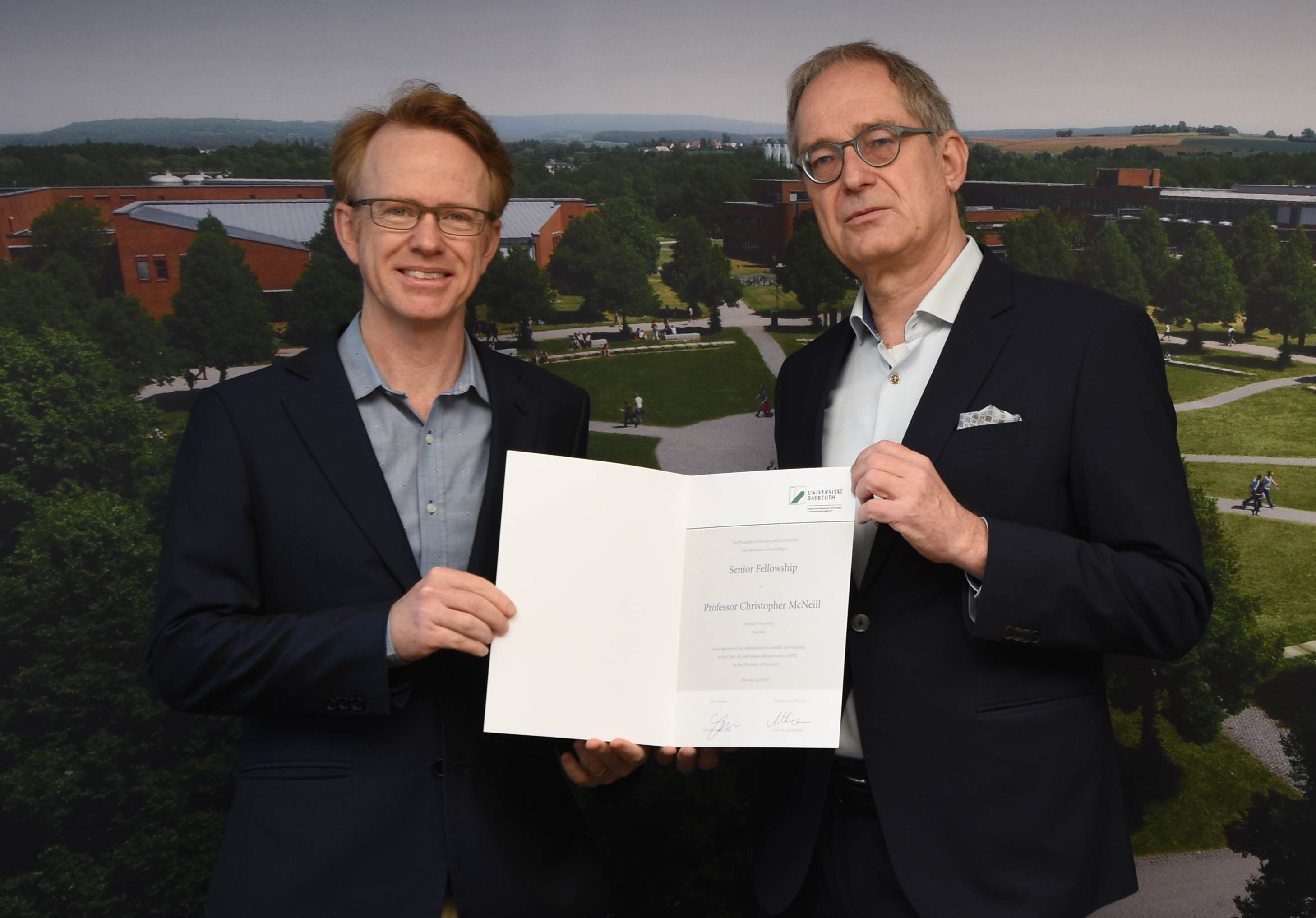Meet the Fellow: Chris McNeill
Control of heterojunction alignment and orientation in organic solar cells
During his Senior Fellowship, Professor Chris McNeill from Monash University in Australia aimed at enabling a new generation of electronic devices that are flexible and stretchable together with his hosts, Professor Anna Köhler and Professor Eva Herzig. Besides his Fellowship, Chris McNeill is stongly connected with Bayreuth having joint PhD students between Monash University and University of Bayreuth – a great example of multilateral networking and international exchange.

Prof. Chris McNeill and Prof. Dr. Stefan Leible, President of the University of Bayreuth
If you had to explain the research project of your Fellowship to the person you metin the elevator, how would you describe it?
Chris McNeill: Most electronic devices we use are made from brittle semiconductors like silicon. While silicon is an amazing material and is widely used for computer chips and solar panels, its mechanical properties and energy-intensive processing restrict its applications. Organic semiconductors are a different class of semiconductors that are based instead on carbon-based molecules and polymers. Organic semiconductors in contrast to silicon can be quickly and cheaply processed, and are enabling lightweight, flexible devices to be made. The vision for the organic semiconductor research community is to enable a new generation of electronic devices that are flexible and stretchable, extending the benefits of semiconductors to new areas and applications.
What does international research mobility mean to you?
CM: International research mobility means being easily able to travel between countries and interact with researchers worldwide. This extends to my group members as well, where I now have joint PhD students between Monash University in Australia and Bayreuth University in Germany. The possibility for these joint students to spend 1 year abroad provides an invaluable opportunity to develop their academic careers and experience other cultures and ways of doing science. I am also fortunate to be involved in an International Research Training Group which links myself and my joint students to a broader research effort involving 9 German-based investigators and 9 Melbourne-based investigators.
What was your personal experience during your stay?
CM: Bayreuth served as a good base for exploring the local area with my wife who accompanied me. The local scenery is very beautiful, with many walks with stunning views readily accessible. From the town it is easy to get out into fields and forests. We also enjoyed learning more about the rich history of the area, enjoying the local culture such as concerts, and experiencing many Christmas markets. Personally, I also enjoyed the quality and variety of the beer from local breweries. If I had to choose a favourite spot in Bayreuth, it would probably be the Markgräfliches Opernhaus, and a favourite spot in the region would be the Fichtelgebirge.
What were your expectations when you applied for the Fellowship?
CM:The main goal was to allow time to make new connections, understand how things work at Bayreuth, and allow space for new research ideas and directions. In the contex of the International Research Training Group I am involved, understanding how things work here and developing personal connections with the people I will be working over the coming years was especially important.
Have you noticed any differences or similarities between UBT and your home university?
CM: One obvious thing is paperwork! Things at Bayreuth happen a lot more here using physical paper, whereas at Monash things have gone more electronic. On the other hand, at Monash we seem to have more paperwork in terms of health and safety and for internal approvals for grant applications.
The Fellow
Chris McNeill is a Professor of Materials Science and Engineering at Monash University. He obtained a PhD in experimental physics from the University of Newcastle (Australia) and then spent nearly 6 years at the University of Cambridge where he was an EPSRC Advanced Research Fellow. He returned to Australia to Monash in 2011 supported by an ARC Future Fellowship and veski innovation fellowship. His research interests include organic semiconductors, perovskite solar cells and synchrotron science. He is particularly interested in the intersection between the device physics and microstructure of solution-processed semiconductor devices.
